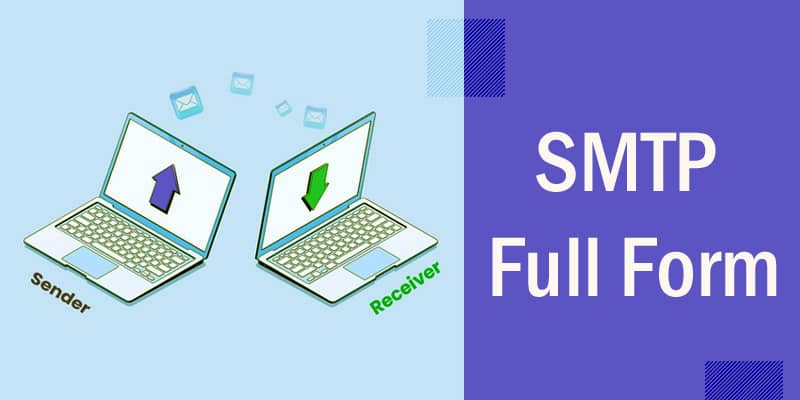The full form of SMTP is Simple Mail Transfer Protocol.
Introduction
SMTP is defined as an application layer of the TCP/IP protocol that moves email on and across networks using a process called ‘store and forward’. In other words, SMTP is a program used for sending data/messages via mail addresses to one or more recipients. SMTP is developed and maintained by the Internet Engineering Task Force (IETF). Simple Mail Transfer Protocol is also named RFC 821 and RFC 2821.
SMTP plays a significant role in setting up communication rules between servers. SMTP functions only when computers are connected continuously with Internet Service Providers (ISP). The ISP servers then deliver the mail to the users having devices with Internet connectivity.
This article includes the full form of SMTP and its components, the working process of SMTP, advantages as well as disadvantages of SMTP. Let’s have a look at them.
Components of SMTP
- Mail User Agent (MUA) allows to receive and send mail.
- Mail Submission Agent (MSA) receives mail from MUA and cooperates with an MTA for delivery of the mail.
- Mail Delivery Agent (MDA) responsible for the delivery of mail to the local recipient’s mailbox.
- Mail Transfer Agent (MTA) receives incoming mail from local users and forwards outgoing mail for delivery. More than one MTP can be added, acting either as a client or server to transfer the mail.
Working of SMTP
- When a mail is sent, the mail client handles the transfer process by interacting with the SMTP server.
- At first, a mail is composed including descriptive information such as the subject of the mail, the content of the mail, etc.
- Submission of Mail: The mail client submits the completed mail to the SMTP server by using SMTP on TCP port 25.
- Delivery of Mail: The SMTP server breaks the recipient mail address and divides it into two parts: username of the recipient and domain name. For example, nikita@gmail.com, where “Nikita” is the username of the recipient and “gmail.com” is the domain name. If the domain name of the recipient is the same as that of the sender, then the SMTP server would hand over the mail to the POP3 server for domain using the delivery agent. If the domain name of the recipient’s mail address differs from that of the sender’s, then MSA will send the mail to the Mail Transfer Agent (MTA). The MTA searches the MX record from the Domain Name System to obtain the target domain. The MX record contains the domain name and IP address of the recipient’s domain. Once the record is located, MTA connects to the exchange server to transfer the message.
- Receipt and Processing of Mail: Once the incoming message is received, the exchange server delivers it to the incoming server (Mail Delivery Agent) which stores the mail until the user retrieves it.
- Access and Retrieval of Mail: The stored email in MDA can be retrieved by using MUA (Mail User Agent) which can be accessed by using login and password.
The SMTP server decodes straightforward text commands like HELO, MAIL, RCPT, and DATA. The most common controls are:
- HELO: Introduce yourself
- EHLO: Introduce yourself and request extended mode
- MAIL FROM: Specify the sender
- RCPT TO: Specify the recipient
- DATA: Specify the body (To, From, and Subject) of the message.
Advantages of SMTP
- SMTP offers a simple platform for communication via mail messages between various computers in a particular network.
- SMTP is reliable as it tries to resend the unsuccessfully sent message until the transmission becomes successful.
- Bulk email marketing is possible via SMTP servers as it is one of the most cost-effective ways of sending out emails to a large number of recipients at a single go.
Disadvantages of SMTP
- The SMTP server is insecure and can be easily hacked. Fake mails can be sent by using any mail address to any recipient.
- Actions performed through an SMTP server may be limited by the rules and other criteria configured by the host server.
Conclusion
So this was all about SMTP, its full form, the components of SMTP, the functioning of SMTP, and its advantages and disadvantages. If you still have any doubts or queries related to SMTP, do write to us through the comments section. We would get back to you at the earliest.

